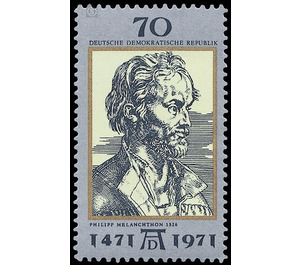500th birthday of Albrecht Dürer - Germany / German Democratic Republic 1971 - 70 Pfennig
Theme: Calender
| Country | Germany / German Democratic Republic |
| Issue Date | 1971 |
| Face Value | 70.00 |
| Color | black grey |
| Perforation | K 12 1/2: 13 |
| Printing Type | offset |
| Stamp Type | Postage stamp |
| Item Type | Stamp |
| Chronological Issue Number | 1416 |
| Chronological Chapter | GER-DDR |
| SID | 377702 |
| In 15 Wishlists | |
500th Anniversary of Albrecht Dürer On the occasion of the 500th birthday of Albrecht Dürer, the Ministry of Posts and Telecommunications of the German Democratic Republic issues three multicolored special postage stamps. Albrecht Dürer On the occasion of his 500th birthday on May 21, 1971, the German Democratic Republic honors the great painter, graphic artist and art theorist Albrecht Dürer. It continues a tradition that goes back to the dawn of the working-class movement and is supported by the idea that everything that has been valuable and forward-looking in the history of human society has entered the culture of the working class and victorious socialism as a permanent legacy is recorded. Dürer's rich work is marked by the great class struggles of the early bourgeois revolution, which culminated in Germany in the Peasants' War and the Reformation. Allied with the progressive forces of his time, he gave an artistic synthesis in a unique synthesis of the whole variety of her worldview and in his realistic art formulated an ideal of the creatively acting human being who determines his fate. This image of humanity, which only begins to be fully fulfilled in socialism, the deep humanistic content and the beauty of its works are the reasons for the current significance of the great Renaissance master in the present. The portrait of Philipp Melanchthon, Luther's comrade-in-arms, on the 70-pfennig value is an example of Dürer's many painted, drawn and engraved portraits. This is again a section, because on the copperplate, which served as a template, there is still an inscription plate. The essential feature of this paper, however, is the psychologically finely differentiated presentation of the important reformer. Dürer created this graphic at a time when he devoted himself almost exclusively to the portrait and his art-theoretical and art pedagogical studies. It shows its mature mastery and is at the same time a commitment to the Reformation. Like many people of that epoch, Dürer recognized in the Roman Church as an instrument of power of feudalism an institution hostile to social progress and expressed its solidarity with those who fought against it.


